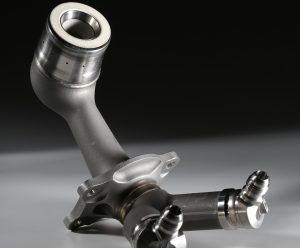 GE Aviation will always be known for its 3D printed fuel nozzles, which it began producing in 2015. The complex components became something of a symbol for how 3D printing can change manufacturing, and this week GE Aviation hit a milestone – it produced its 30,000th 3D printed fuel nozzle at its Auburn, Alabama plant.
GE Aviation will always be known for its 3D printed fuel nozzles, which it began producing in 2015. The complex components became something of a symbol for how 3D printing can change manufacturing, and this week GE Aviation hit a milestone – it produced its 30,000th 3D printed fuel nozzle at its Auburn, Alabama plant.
“This milestone isn’t just about reaching production of 30,000 fuel nozzle tips,” said Ricardo Acevedo, plant leader for GE Aviation Auburn. “The team should also be proud for their role in helping prove additive technology works in mass production for our business and others who buy GE technology.”
In 2014, GE announced plans to invest $50 million into its existing 300,000-square-foot Auburn facility, in preparation for taking on more additive manufacturing. The facility now has more than 40 3D printers churning out parts, and 230 employees currently work at the plant, which is continuing to grow. The number of employees is projected to grow to 300 in 2019.
A fuel nozzle is part of any engine that runs liquid fuels. It is responsible for spraying fuel into the engine, and it needs to be strong and capable of withstanding high temperatures, not to mention precise so that it can release the right amount of fuel at the correct rate. It’s a complex component, one that used to be made up of many parts – about 20, in fact, and those parts had to be separately manufactured and then welded together. By using 3D printing, GE Additive was able to produce the entire component, with all of its twisting geometry and interior chambers, in one single part.
 Not only did 3D printing save an incredible amount of labor and time, but it also reduced the weight of the fuel nozzle by 25% and made it about five times stronger. Both the 3D printing and aviation industries, understandably, lost their minds a little bit when they learned about what GE Aviation had done. Thousands of orders immediately poured in for GE’s LEAP engine, which was equipped with the 3D printed nozzles, and the component became part of countless presentations as a tangible example of what 3D printing could do.
Not only did 3D printing save an incredible amount of labor and time, but it also reduced the weight of the fuel nozzle by 25% and made it about five times stronger. Both the 3D printing and aviation industries, understandably, lost their minds a little bit when they learned about what GE Aviation had done. Thousands of orders immediately poured in for GE’s LEAP engine, which was equipped with the 3D printed nozzles, and the component became part of countless presentations as a tangible example of what 3D printing could do.
The LEAP engine is the best-selling engine in the aviation industry, and the 3D printed nozzles saved a remarkable $3 million per aircraft. LEAP engines are known for their fuel efficiency, which is up to 15 percent better than the best CFM56 engines. Total LEAP engine orders are currently at over 16,300. The engines are a product of CFM International, a joint venture between GE and Safran Aircraft Engines.
“We’re leading the way of mass producing additive parts for the industry,” said Acevedo. “We’re continuously looking at ways of expanding the possibilities for the business.”
And the business will be expanding. Earlier this year, GE Aviation opened a new $200 million factory complex in Huntsville, Alabama that will be America’s first production center for unique materials used to manufacture ceramic matrix composites, or CMCs. CMCs are extremely lightweight and can withstand very high temperatures, so they’re a major source of excitement for the aircraft industry right now. GE Aviation might be taking a moment to celebrate its 30,000 fuel nozzle milestone, but it certainly isn’t pausing its work.
Discuss this and other 3D printing topics at 3DPrintBoard.com or share your thoughts below.
[Source: Made in Alabama/Images: GE Aviation]
Subscribe to Our Email Newsletter
Stay up-to-date on all the latest news from the 3D printing industry and receive information and offers from third party vendors.
Print Services
Upload your 3D Models and get them printed quickly and efficiently.
You May Also Like
3D Printing News Briefs, September 11, 2025: Project Call, Auto Color Mapping, & More
We’re starting with America Makes news in today’s 3D Printing News Briefs, as a new project call for continuous fiber AM was recently announced. Moving on, there are two stories...
Meltio Gains Credibility and Efficiency: Real Industrial Parts Reinforce its AM Solutions
Meltio‘s metal AM solutions are helping industries around the world to efficiently manufacture and repair metal parts in 3D, consolidating their credibility in the market. Compared to conventional manufacturing methods,...
3D Printing News Briefs, September 6, 2025: SBIR Awards, Regenerative Medicine, & More
In this weekend’s 3D Printing News Briefs, we’ll start with some exciting funding news, as NIST has awarded over nearly $2 million to small businesses working to advance AI, additive...
This Swiss Ice Cream Shop Was 3D Printed from Recycled Plastic—and It Looks Amazing
In the Alpine village of Mulegns, Switzerland, a new experimental ice cream shop looks like something out of a dream. From the outside, it resembles a classic wooden barn. But...


































